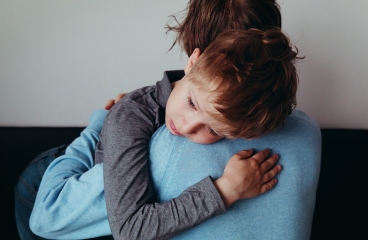Childhood Fears and Exposure to Violence
Overview

Your child may seem anxious about everyday things. School-age children usually have a number of fears that began in their early childhood, such as fear of ghosts, of the dark, or of dying. Every child's fears are different. Parents may not recognize that some behaviors are based on fears.
Children this age try to deal with, minimize, or get rid of these fears. They may do this by pretending to be heroes or villains, by watching scary movies, and by acting tough and fearless. Some children may want to learn all about the things that scare them. They try to overcome their fear by becoming experts on the subject.
Some children may respond to fear by wanting greater control over things that scare them. They may enjoy fantasy shows and books where the characters are brave, smart, and clever and have unusual powers. For example, they may like shows and books that feature superheroes.
It can take time for children to stop believing in scary things, such as ghosts. Comfort and reassurance from parents can help. As children get older, most of them let go of their fears.
Helping children deal with their fears about violence
Most children are exposed to violence on TV, in movies, and in other media. Some children may experience violence directly. Here are some ways you can help them deal with their fears.
- Pick the right time to talk.
Give children a way to express themselves. Make time to talk when you and your child feel unhurried and relaxed, such as at dinner, at bedtime, or when you're walking home from school. Avoid starting a conversation when your child is upset or highly emotional about an issue. Let children know that you are open to talking to them by being interested in what happens in their lives.
- Let them tell you what they know.
Build your conversation around their questions and what they know about an issue or event, not around what you know. Children don't understand violence in the same way that adults do.
- Give reassurance.
Reassure your children that they are safe. Children often think that the same scary thing will happen in their town or school or to themselves.
- Let them learn from the experience.
Give children a way to learn from what scares them. Bring up an example of how they or someone else solved a conflict without using violence.
- Help them use activities to express feelings.
Support children's efforts to work out scary news through play, drawing, or other activities.
How do children react to violence?
As a self-protection measure, your child may react in ways that concern you. Don't be alarmed by common reactions to violence, such as:
- Ignoring the event or acting like they don't care.
- Having a fascination with a violent event. For example, a child may want to continually talk about something violent and ask parents detailed questions.
- Playing in violent ways, such as pounding an action figure on the floor. This behavior is a way that children work out issues. It is not a sign that they have violent tendencies.
Related Information
Credits
Current as of: October 24, 2024
Author: Ignite Healthwise, LLC Staff
Clinical Review Board
All Healthwise education is reviewed by a team that includes physicians, nurses, advanced practitioners, registered dieticians, and other healthcare professionals.
Current as of: October 24, 2024
Author: Ignite Healthwise, LLC Staff
Clinical Review Board
All Healthwise education is reviewed by a team that includes physicians, nurses, advanced practitioners, registered dieticians, and other healthcare professionals.


